This section contains almost all the most beautiful and common aquarium fish.
In the articles you will find detailed description, origin, features of maintenance and care, compatibility with other species aquarium fish.
Particular attention is paid to breeding aquarium fish at home.
The information posted in this section, as well as throughout the site, will be useful not only for beginners, but also for experienced aquarists.
We are constantly editing and adding interesting and, most importantly, useful information about aquarium pets.
Habitat: South-west India and Sri Lanka. Description: The body length of the aquarium fish Zebrafish Malabar is up to 15 cm, in an aquarium it is smaller - up to 10 cm. The body is elongated in length, the profile of the back and belly is evenly curved, the sides are strongly flattened. Two pairs of antennae, one of which may be missing. The color of the back is olive green, the belly is yellowish or reddish to orange. There are 3-4 longitudinal, shiny stripes along the entire side blue color, which are separated by stripes of golden-red color. Behind the cover of the gills there are several transverse stripes of golden color. In males, the middle longitudinal stripe of blue color continues in the middle, and in females it appears on the upper lobe. Pisces like to stay in the upper and
Lives: In reservoirs in the north of South America, Guiana, and the upper reaches of the Amazon. Description: The body length of pristella fish is four to five centimeters. The body is flattened, translucent, high. In the rays of the sun the fish glows like silver. Females are plumper and larger than males.
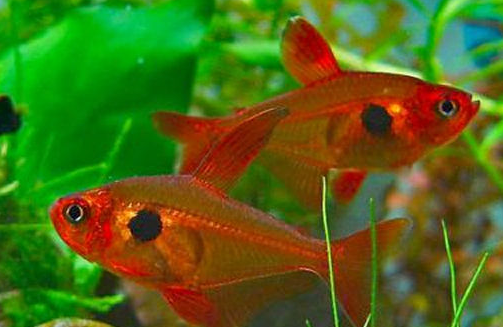
Area: America. Description: Has an exceptionally bright color. The darker light brown color of the back of the von Rio tetra smoothly transitions into the sides shimmering with a dark silvery sheen, crossed by three brown transverse strokes in the front of the body, immediately behind the gill covers. The back of the body, starting from the anterior edge of the dorsal fin to the anterior edge of the anal fin, and all fins are colored blood red color. The anal fin of the male is outlined along the outer edge with a black edging, which is absent in the female. Females reach a length of 3.5, males - 2 cm, the latter are slimmer and thinner than females. The brightness of the color varies greatly depending on the living conditions and mood of the fish. The color reaches special brightness in the evenings when
Lives: In the fast-flowing waters of the Laplata Lowland (Paraguay). Description: The body size of aquarium loricaria fish can reach 25 cm. Females, unlike males, do not have brushes on their pectoral fins. Females are larger than males and have a blunter dorsal fin. Loricaria are armored catfish that lead a bottom-dwelling lifestyle. These catfish have a mouth that allows them to stay in the strongest currents due to the suction cup, but also to scrape off fouling, which is the main food for this type of fish in nature.
Lives: In the Amur River basin. Description: The body of aquarium fish is a killer whale - a mouse up to five cm long. The shape of the body is typical for killer whales. Short mustache. The spine on the pectoral fin along the outer edge is without serrations. The color is dull: the silver body has continuous longitudinal stripes of gray-brown color. This is the smallest of the domestic killer whales. The male is slimmer and smaller than the female.
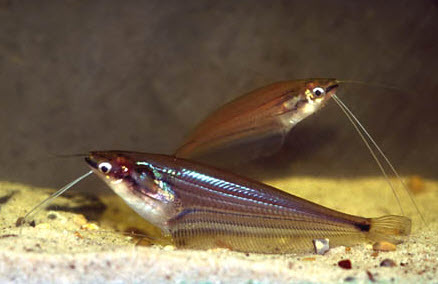
Lives: In the rivers of Sumatra and Borneo. Description: The body length of the fish is up to 18 cm. The body is strongly flattened laterally, elongated. A very small dorsal fin, inconspicuous, adipose - absent, anal - long. The eyes are large and black. Two pairs of long mustaches. Transparent body. On the caudal fin, at its base, there is a triangular black spot. This catfish is very similar to the Indian glass catfish, so it is very easy to confuse them. Main differences: The Indian catfish has one pair of short whiskers, and it lacks a dorsal fin and a black triangular spot. There are suggestions that the caudal fin is longer in males.
Habitat: In the Ucayali River (Peru). Description: The body length of aquarium Corydoras leopard fish is up to six cm. The main color is yellowish-gray with a metallic sheen. There is an evenly spaced pattern throughout the body, which consists of dark, sinuous lines; a sinuous, narrow black stripe runs toward the head from the tail. In the male it almost reaches the gill cover, in the female it is interrupted in the middle of the body. There is a black spot at the top of the dorsal fin, and there are also five to seven vertical streak-like stripes on the anal fin. Light belly, no pattern.

Area: North America. Description The body shape resembles a roach. The scales of Tetragonopterus are large, shiny, silver in color with a greenish tint. The caudal, anal and ventral fins are bright red, the dorsal and pectoral fins are transparent and white. In the middle of the body from head to tail there is a green stripe that merges with the general background, which at the base of the tail turns into a black spot that looks like an elongated diamond. Adult females reach a length of 10 cm, males are much smaller and have a slimmer body. The coloring of males and females is exactly the same.
Habitat: Brahmaputra and Ganges rivers. Description: The body length of the aquarium fish honey gourami is up to 10 cm. The end of the female is rounded; the end of the male is pointed. The main body color ranges from yellow-brown to orange-red. A dark brown stripe runs along the side from the eye to the base, with a silvery lighter belly. During spawning, almost the entire body of the male, and even the back part, turns from honey yellow to dark red. The chest, front of the head, belly and front of the honey gourami aquarium fish have a dark to black color with the presence of a greenish tint, and a wide edge of light yellow color, becoming narrower towards the end of the fin. Orange-red filamentous rays.

Habitat: Upper Amazon, Brazilian Tocantine River, Ecuadorian Napo River. Description: The body length of aquarium fish Brochis green is up to 7-9 centimeters. Somewhat similar to Corydoras, but Brochis has a taller body. The snout is largely elongated, the caudal fin has a powerful notch. The dorsal fin is too long, almost reaching the fatty fin. The color is discreet: beige-golden with a green iron tint. Mustaches 3 pairs. The caudal fin has 10-12 rays. The male is smaller and slimmer than the female.
Habitat: Maroni River (Guiana). Description: The length of the black phantom fish is up to 3 centimeters. The coloring is dim, but very pleasant: the body is yellowish-pink, behind the dorsal fin is red. The eyes are large, black, and there is a large black round spot behind the gill cover. The male is slimmer and smaller than the female.
Description: The size of aquarium fish, golden catfish, reaches 7 cm. Males are smaller than females and have a sharper dorsal fin. Contents: Aquarium fish, golden catfish, live in the bottom zone. The fish are quite unpretentious and peaceful. Chemical composition water is of no particular importance to them. Catfish are undemanding to oxygen dissolved in water. They eat dry and live food. When actively searching for food, catfish constantly dig into the ground, stirring up bottom sediments. Twilight lighting is preferable. If the aquarium is heavily lit, the fish choose places in it that are protected from direct light by plant leaves, darkened shelters and various crevices (artificial shelters are very suitable for this purpose), so when decorating
Habitat: They live in the reservoirs of the Malacca Peninsula, in the south of Thailand, Sumatra and Java. Description: The body length of the aquarium rasbora fish is up to 45 cm. The male is slimmer than the female. The black triangular spot on the body of the male has a more pointed anterior lower corner, and the triangle reaches the end of the abdomen, and not to its middle, as in the female.
Habitat: Water bodies of Sri Lanka. Description: The body size of the aquarium fish cherry barb reaches 4 cm. The difference between male cherry barbs and females is the presence of bright colors and bright red fins with black trim, especially the anal ones. females have yellow fins.
Lives: In reservoirs of Colombia. Description: The body length of female neon blue is no more than 2-3.5 centimeters, for males - 1.5-2 centimeters. The difference from its closest relatives - red and blue neons - is in its slender, elongated body. There is a luminous blue stripe that runs down the middle of the entire body to the base of the upper lobe of the caudal fin. The red-crimson stripe is short, like blue neon, and often has a faded color; under unsatisfactory conditions the stripe may disappear completely. In addition to the fact that females are larger in size, they are also slightly plumper than males.
Lives: In the upper reaches of the Amazon. Description: The average size of a pulcher usually measures from 4 to 5 cm. In this fish, females have a more pointed anal fin. Contents: Schooling fish. Aquarium from 20 liters (preferably more), with thickets of plants. Lighting should not be too bright. Preferably dark soil. Fish love to be in the bottom layers of the aquarium. You should not keep it with cocky or large fish that can injure or swallow this live “spoonbait.” Aeration, filtration, and weekly changes of up to 25-30% of the water volume are desirable (they cannot tolerate chlorine dissolved in tap water). Water hardness up to 12-15°, pH 6.5-7.0; temperature 23-24 °C (from 18 to 30 °C). When grown
Habitat: In the Amazon and Orinoco river basins, in the reservoirs of Guyana and Suriname. Description: The aquarium fish Anostomus vulgaris has a dark, fusiform, elongated body that reaches a length of 18 centimeters; two or three golden longitudinal stripes stretch across its entire body. The fins are bright red in color. Males are more brightly colored, their bodies are slimmer and smaller than those of females.
Habitat: Swampy, partially dry mountain reservoirs of Cameroon. Description: The size of aquarium fish Afiosemion striatum reaches up to 6 cm, the female is usually smaller than the male. The male is larger, has a bright color, and elongated ends of the fins. In nature, fish live 1-2 years and upon reaching sexual maturity, spawn throughout their lives almost every day.
Description: The male aquarium fish Ctenopoma congo grows up to eight cm, the female is slightly smaller. Congolese ctenopoma loves very soft water. Contents: This aquarium fish Ctenopoma Congolese is crepuscular, and during the day it hides in shelters.
Habitat: Reservoirs of the northern part of South America, with the exception of the river. Magdalena. Description: The body length of cichlas severum is up to 20 cm, less in an aquarium. The main color is yellowish, greenish to dark green, brown or almost black. Young fish have 8-9 black transverse stripes on their sides, which disappear in adults (they may remain on the caudal peduncle). Each scale is spotted with a dark, yellow or pink spot, so that rows of broken lines run along the side of the body. At the base of the soft-ray part there is a dark round spot with a light border. The male has a head with red-brown or green-blue spots and streaks.
Lives: In coastal reservoirs with brackish and fresh water of the Yucatan Peninsula (Mexico). Description: The body of a male molynesia velifera is up to 15 cm long, that of a female is up to 18 cm, in a smaller aquarium. The body is elongated and has a high caudal peduncle. The male’s body ranges from soft blue to green-blue, on the sides there are rows of longitudinal luminous spots of whitish-green color, the chest and throat have a rich orange color. The fins have an orange border with a black edging. The female is bluish-gray with rows of dark dots.
Habitat: Amazon River basin, as well as the Parana and Paraguay river systems. Description: The size of astronotus aquarium fish reaches up to 35 cm. There are no pronounced gender differences. Being large in size, Astronotus still remains one of the most beloved fish among aquarists.
Habitat: Congo River. Description: The body length of aquarium fish Distichodus silver is up to 12 centimeters. Females are slightly larger and plumper than males, and during the breeding season they develop an ovipositor. The color is beige-silver, there are “speckles” on the sides, the fins are framed by a beige border.
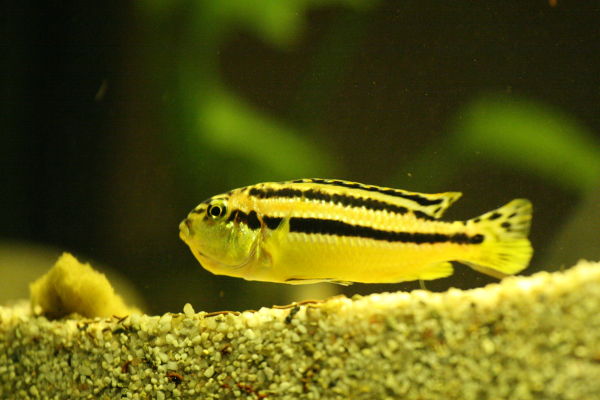
Table of contents: Melanochromis auratus description Auratus melanochromis golden habitat in nature Golden parrot fish detailed description Difficulty in keeping a golden parrot in an aquarium Feeding golden parrot fish Keeping auratus melanochromis golden in an aquarium Compatibility of cichlids golden parrot Sexual differences in golden parrots Breeding auratus melanochromis golden
Lives: In reservoirs of the northern regions of South America. Description: Aquarium coin fish have a beautiful silver color, not very bright, are easy to breed and unpretentious. The body of the fish is high, strongly flattened laterally, almost disc-shaped. The whole fish turns silver in side light, while in top light the sides, abdomen and gill covers turn silver. There are black spots behind the gill covers and at the base of the tail. The body reaches a length of up to 10 centimeters. The female is plumper and larger than the male, has a pale anal fin and a rounded anterior end of the fin. The anal fin of the male is colored and slightly curved.
Description: The body length of aquarium fish Bocia Lecomte is up to 15 centimeters. The profile of the back is curved, the belly is almost straight. The back is gray-green, the side is green with a blue or purple tint, and there is a dark gray spot on the caudal peduncle. The fins are orange to reddish in color.
Description: Ctenopoma leopardii has a bright color: the background is olive-colored with a bluish tint, with scattered dark spots on it and the fins (except for the caudal one), a vertical light stripe runs along the caudal peduncle, a dark caudal fin, huge eyes in comparison with the size of the body. This is a coloring page for the night robber. a predator, that’s why there should be such eyes, the contours of the fish are hidden by spots, and its size is hidden by a dark tail. Adults of this species (about 20 cm) acquire a muddy green color, with a dark spot on each scale. Males of the aquarium fish Ctenopoma leopardii have mysterious spines on the caudal peduncle and behind the eyes, some species have two
Habitat: Reservoirs of eastern Brazil and Paraguay. Description: The length of the aquarium fish Tetra Scholz is up to 5 centimeters. It is dimly colored; along a silvery background there are longitudinal narrow golden stripes and a wider black stripe underneath. There is a large black spot on the caudal peduncle, at the base of the caudal fin. The fins are colorless, the ventral and anal fins have white stripes. Female Scholz tetras are larger and plumper than males, and their caudal fin is more strongly carved.
Lives: In the reservoirs of Suriname, Guyana, and the Amazon basin. Description: The fish Nannostamus marginatus has an elongated valval body, which is characteristic of the entire genus. The body is decorated with longitudinal golden and brown stripes. The unpaired fins are decorated with black edging and are partially red in color. The maximum length is 4 centimeters. The mouth is small. Like other nannostomuses, there is no adipose fin. Males are slightly smaller and slimmer than females and are also more contrastingly colored. At night, the central stripe becomes intermittent and the fish seem to become discolored.
Habitat: Homeland - tributaries of the Lower Amazon. Description: Reaches a length of 4.5-5 centimeters. The male is slimmer and brighter than the female. Its anal fin has a wide black edge; in the female it is a thin stripe. Male lemon tetra aquarium fish have a shortened and thickened swim bladder, while females have a narrower and curved swim bladder. The main background of the body is lemon yellow.
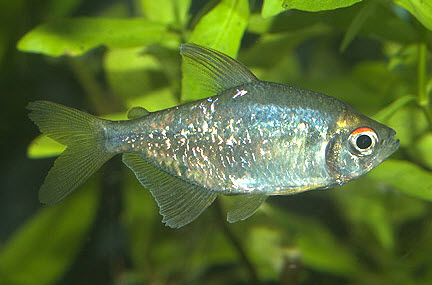
Habitat: The aquarium fish inhabits the diamond tetra lake. Valencia and its surroundings (Venezuela). Description: Length up to 6 cm. The main body color of the tetra is grayish with a yellowish to reddish tint, the back is gray-blue to brownish, the belly is silvery-white. In reflected light, numerous small golden, copper or silver spots shine on the body. The upper half of the iris is red. The fins are gray to black, milky white at the end. The male is more intensely colored and greatly enlarged.
Habitat: Border river between Brazil and Bolivia. Description: The length of the black phantom is up to 4.5 centimeters. The male is dark gray, almost black, the female is dark brown, the anal fin is red with a black edge. The male's dorsal fin is highly elongated. It differs from the red phantom by the pearlescent edging around the black spot on its side.
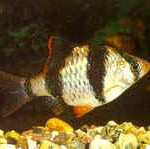
Description: The average body size of the aquarium fish Sumatran barb is seven cm. The difference between the male Sumatran barb and the female is the presence of intense red coloring of the upper part of the stigma, as well as the lateral and dorsal rays of the caudal fin. Female Sumatran barbs have less bright coloring and a more rounded abdomen.
Distribution: Amazon and Paraguay river basins, as well as Guyana rivers. Description: The length of Cichlazoma mezonuata is up to 20 cm, in an aquarium up to 15 cm. The main color varies greatly, yellowish-gray, brass-yellow, greenish-yellow or gray-green. A black stripe runs from the snout through the eye to the soft-rayed part. Above it, the body acquires a darker color. Dark transverse stripes sometimes appear on the side, consisting of small spots. On the caudal peduncle there is a black spot with a white edge. The fins are gray-yellow to bluish with rows of white, sometimes also brown, spots.
Habitat: Reservoirs of South and Central America. Description: Acara aquarium fish live in aquariums from 4 to 15 years. Their body is high, compressed at the sides. The head is large, the forehead is convex. Big eyes and thick lips. The fins on the back and near the anus are long, the dorsal fin stretches along the entire back from the back of the head to the base of the tail.
Habitat: Inhabits the lake. Managua and Nicaragua (Nicaragua). Description: The length of the male lemon cichlazoma is up to 30 cm, the female is slightly more than 20 cm. There are fewer fish in the aquarium. Body color changes with age, but not always. Juveniles are yellowish-gray to dark gray-blue in color, with 6-7 dark transverse stripes on the side and a dark spot along its middle. Adult specimens of lemon cichlases are light yellow to orange-yellow, and may have black spots on the side and fins. The unpaired fins are bluish. In males, the line of the forehead above the eyes is depressed; with age, a fat pad may form.
Habitat: Amazon. Description: The body length of the flashlight fish is up to 4-5 centimeters. It got its name because of the bright orange “glowing” spots located at the base of the tail and behind the gill cover. Males are smaller, slimmer, the anal fin has a hook with which it can cling to a net.
Habitat: Rio Araguaia River (Brazil), Peruvian Amazon. Description: Length up to 6 centimeters. The background of the body of Taieria belke is olive-silver, from the gill cover to the end of the lower lobe of the caudal fin stretches a black curved stripe, reminiscent hockey stick. Males are slimmer and smaller than females.
Habitat: Ternetia aquarium fish inhabit the basins of the Paraguay and Rio Negro rivers. Description: Length up to 6 cm. The body is moderately elongated in length, quite high, ovoid, strongly flattened on the sides, the lateral line is complete. There is a bilobed adipose fin. The back is olive-green, the side is silvery with a yellowish to bluish sheen. In the anterior part of the body there are 3 black transverse stripes through the eye, behind the gill cover and from the beginning, which become gray with age. Young fish have black back parts and adipose fins. The male may remain black in color, with a whitish tip. The female aquarium fish Ternetia is larger.
Lives: In the Amazon River basin, in the reservoirs of Guiana and Suriname. Description: The body height of aquarium fish Mileus redfin in an aquarium is up to ten centimeters, in nature they grow up to 35 centimeters. They have a silver-gray, disc-shaped body. The anal fin is reddish; in males it is notched or may have longer first rays.
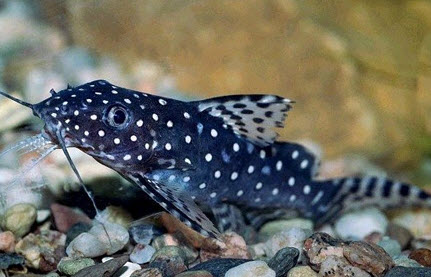
Lives: Inhabits tropical Africa. Description: The body of aquarium fish Synodontis is stocky, somewhat elongated in length, slightly flattened on the sides, covered with durable and slimy skin. The profile of the back is curved more strongly than the belly (with the exception of the female ready for spawning). Three pairs of antennae. There is a large adipose fin. The male is slightly smaller.

Description: The size of the aquarium fish Sumatran barb (mutant) reaches 7 centimeters. These gracefully colored barbs are a mutation of barbus tetrazona. Mutants are in many ways similar to ordinary Sumatran barbs, but are considered their weakest and most fragile form.
Habitat: In the reservoirs of India, Burma, Laos, Sri Lanka. Description: The length of the cobalt killer whale aquarium fish is 10-20 cm. Their body is elongated, with a large head. The main color of the background is silver-gray, the color of the back is blue-gray with a purple tint, and on both sides there are two narrow stripes of the same color. The body of males is slimmer, smaller, and they are colored more contrastingly.
Habitat: Korea, China and Japan. Description: The body size of aquarium fish veiltail (goldfish) is 10-20 centimeters. The initial shape of a goldfish is like that of a brightly colored Chinese goldfish. The male goldfish has saw-like growths on the first ray of the pectoral fin and a snow-white rash on the gill covers.

Habitat: In the rivers of Southeast Brazil, Paraguay, Uruguay. Description: The body length of aquarium fish is speckled up to 7 centimeters... Natural coloring is a grayish background, with black spots scattered throughout. Albino and veiled forms are known.
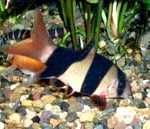
Habitat: Waters of Sumatra and Kalimantan. Description: Aquarium fish botsia clown have 4 pairs of antennae, there is no protective skin on the eyes, a double spike is noticeable under any eye, which the fish has the ability to strain and relax. It grows up to 30 centimes. length.

Live in: In brackish and fresh water bodies along the Gulf of Mexico. Description: The body of the male aquarium fish molynesia reaches a length of up to 10 cm, in the female up to 12 cm. The body is elongated in length, quite high, sometimes exceeding the height of the body. Color varies greatly. The female is paler in color than the male. There are completely black and piebald forms, and there are also albinos.
Description: The body size of marble gourami aquarium fish is up to 15 cm. The male has a pointed and more elongated dorsal fin. Contents: The fish is omnivorous, hardy and gets along well with any other representatives of aquarium fish. Destroys hydra, which is very useful in an aquarium. When kept in an aquarium, the carbonate hardness of the water should be minimal. Maintenance conditions: GH up to 20°; pH 6.5-7.5; t 20-25°C.
Habitat: Rio Negro River (Brazil). Description: The size of aquarium fish speckled catfish usually does not exceed 7 cm. Female catfish are larger than males, and the latter have an elongated first ray of the dorsal fin. Speckled catfish They have an albino shape with red eyes.
Lives: In the Brahmaputra and Ganges rivers. Description: The body length of aquarium fish Lalius is up to six cm. The male has a dorsal fin pointed at the end, while in the female it is rounded. The male's body is green-blue with 13-18 transverse red stripes that extend to the unpaired fins. From the eye to the chest, the front part of the body has a rich green-blue color. The female's color is the same, but much paler.
Habitat: In the reservoirs of Venezuela and Trinidad. Description: The body length of aquarium fish Corydoras golden is up to seven cm. Along the body along its length there is a wide shiny stripe of dark green color, above it, slightly short of the dorsal fin, there is a golden narrow luminous stripe. The color of the back is dark brown, the belly is light. Transparent brownish fins. This is a fairly cold-loving species; its optimal temperature is 20-24 °C.
Habitat: Amazon River basin. Description: The size of the aquarium fish Ancitrus stellata is up to 10 cm. The male, unlike the female, has outgrowths at the end of the stigma. More than half of the diet of the aquarium fish Ancitrus stellata should consist of plant foods.
Habitat: Zebra tilapia aquarium fish inhabit the eastern part of Africa from the headwaters of the Nile River to the province of Natal (South Africa). Description: The body length of aquarium fish zebra tilapia is up to 35 cm, in an aquarium up to 15 cm. The body is elongated, ovoid, moderately high, somewhat flattened on the sides. The head is large, the mouth is very large, the lips are swollen. The body is gray to gray-green, with a silvery sheen and dark spots on the side that may form stripes.
Habitat: Inhabits small forest streams in the northwestern part of the Cordillera (Colombia). Description: Length up to 6cm. The body is elongated, slightly flattened on the sides, the profile of the back is more curved than the belly. The back is olive-brown. On the side there are 2 wide shiny stripes, the upper one is light green to green-blue in color, the lower one is dark brown to black and extends to the middle rays of the “C”. The belly is yellowish-white. The iris of the eye is green-blue. The fins are yellowish to light yellow-green edged, under which there is a narrow dark purple stripe. The male's outer and middle rays are strongly elongated. The female is less intensely colored, the middle rays are slightly elongated.
Lives: In reservoirs in the vicinity of Buenos Aires (Argentina). Description: The body length of the aquarium fish Tetra roach is up to ten centimeters, in an aquarium up to seven centimeters. The back is olive-green, the side is silver with a yellowish to bluish-green tint, and the belly is silvery. At the end of the caudal peduncle there is a black diamond-shaped spot that extends to the fins. The color of the fins of the male is more saturated with red. There are mutants that are lemon-yellow in color.
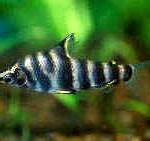
Habitat: Amazon and Orinoco river basins. Description: The length of aquarium fish Abramites marble reaches up to 13 centimeters. The body is fusiform, vertical dark gray, almost black, stripes run along a gray background. Fish swim tilted at an angle of about 40° to the ground. Females are plumper and slightly paler in color than males.

Habitat: Fast flowing waters of Thailand. Description: In nature, aquarium fish Girinochaylus reach a length of 25 cm, in aquariums they grow twice as small. The fish resemble minnows in color and shape. They have a typical lower mouth, with the help of which fish attach themselves to plants and various underwater objects, which is why they are called suckers; the back is olive-colored, the belly is whitish, along the entire body from the end of the head to the base of the caudal fin there is a black stripe with protrusions upward, and above it a yellowish stripe. Fish carefully eat fouling of plant and animal origin and are in constant motion. One pair of suckers in a 70-100 liter aquarium is usually enough to
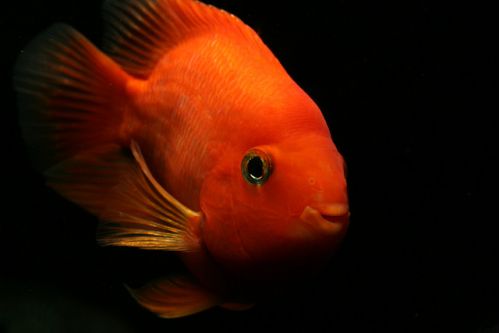
Lives: In South America, Amazonia. Description: Only the very name “Piranha” or “Piraya” often encourages aquarists to keep these dangerous schooling fish. Length of fish: about 27 cm. An adult male has a red belly and chest. During the breeding season, its body turns black.
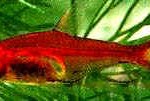
Habitat: Rio Manso River (Brazil). Description: The body of the Amanda aquarium fish is elongated, the fins are unpaired and have a reddish color. The first ray on the dorsal fin is light cream. Golden eye color. The length of individuals reaches up to 3 centimeters, females are slightly larger than males. More often the fish are smaller in size.
Habitat: Congo River basin. Description: A large fish species that can grow up to 40 centimeters in favorable conditions. Aquarium fish Distichodus six-stripes with a bream-like body become increasingly taller with age. The background of the body is yellow with a green tint. Six fairly wide black stripes run across the body. The male is slimmer and smaller than the female.
Habitat: They live in water bodies of Thailand. Description: The body length of the red-tailed rasbora is up to six cm, most often the male is up to four cm, the female is up to five cm. The male is slimmer and has a more contrasting color. Contents: Schooling, peaceful, active aquarium fish. Food - dry, live. They live in aquariums for several years. An aquarium needs to be at least 40 cm long, moderately planted with plants, and have open space for swimming along its entire length; T (17) 22 - 26°C; dH up to 12°; pH b.4 - 7.2. Filtration, aeration, peating of water and its regular partial replacement are desirable.
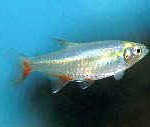
Habitat: in reservoirs of southern Brazil, Paraguay, Argentina. Description: The body of the aquarium fish Afiocharax alburnus is very elongated, the color is bluish-silver. There are colorless fins, all except the caudal one. The color of the caudal fin can range from pale pink to reddish; a dark spot is sometimes visible at the base of the fin small size. Body length up to 7 centimeters. Females are usually slightly plumper than males.
The Danio group of fish constitutes a separate subfamily in the Cyprinidae family, distributed in South Asia. These are small, elongated fish, distinguished by their bright colors and exceptional mobility. Typical representatives of the group are zebrafish, zebrafish, and malabar zebrafish, which are common in our aquariums. These fish have a lot in common (similar structure, lifestyle), so the most popular aquarium fish, zebrafish, is described in detail. Danio rerio (previously called Brachydanio rerio, now Danio rerio) is a live, schooling aquarium fish that reaches a length of up to 6 cm.
Habitat: Tropical Africa. Description: Predatory, elongated, silver-colored aquarium fish. The way of life and body shape of the hepsetus or African characin pike resembles our pike. The mouth is unusually deeply cut with strong, pin-shaped teeth, and the dorsal and anal fins are set far to the rear. A relatively fast, hardy swimmer, which can be injured during transportation. Such injuries often fester, and then practically cannot be cured and ultimately lead to death. It feeds on fish and can live with conspecifics or fish of at least equal size.

Description: An agile, small aquarium cardinal fish with a narrow, elongated body that reaches 2.5-3 cm. More than half of the upper body, including the lower lip and the frontal part of the head, is yellowish-brown. Against this background, along the entire spine from the tail to the eyes there is a narrow strip of golden color, which ends in a large black dot at the beginning of the tail. The abdomen of aquarium fish, the cardinal anal fin, has a silvery-white color. The gill fins are lemon-transparent in color and have a thin black border. The ventral ones are lemon-colored, with pale red edges. The anal fin is yellowish, with a bright red corner. Bicolor dorsal fin. The lower half of it has a deep lemon color, turning into a wide border of bright red.
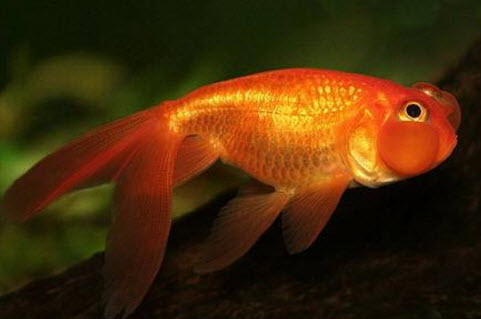
Habitat: Selected form. Description: The aquarium fish's head and snout are short, the dorsal fin is missing, the caudal fin is cut and short. So named because of the protruding eyes above the head, which are bordered by skin and connective tissue and whose pupils are directed upward. The body length of the fish is about 15 cm.
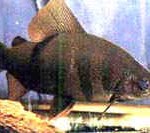
Habitat: Congo River. Description: The body length of aquarium fish Distichodus nosalis is up to 40 centimeters. Externally, it is very similar to Distichodus six-striped. The main difference is the elongated snout (rostrum), which is reflected in its specific name.
Lives: In Malaysia, Sumatra, Thailand. Description: The female is up to 2.5 cm long, the males are slightly smaller and slimmer. Contents: Schooling peaceful aquarium fish. The food is small, live, dry. It is necessary to keep the collection of cuneiforms only with small and harmless species (nannostomus, dwarf catfish, etc.) or separately. The aquarium volume needs to be at least 15 liters and at least 25 cm long, have dark soil overgrown with plants, but need a free area for swimming, brightly lit and shaded areas; T (22) 23 - 25°C; dH 2.5 - 10°; pH 6.0 - 6.8. The water is peaty and old.
Lives: Origin South Vietnam, Cambodia, Thailand. Description: The length of an ordinary betta fish reaches six cm. The main background is black, dark brown, the gill covers have vertical light stripes with red spots on them. Some of the scales, especially closer to the back, have a blue sheen. The dorsal fin is short, slightly rounded at the back (in females it is more rounded and smaller in size), the color is bright blue, on the trailing edge there is a red spot. Pectoral fins are black, red towards the end, and their tips are white. The rays of the rounded caudal fin are bright blue, the space between them and the edge of the fin are red. The anal fin has a transition from black to dark red, red. Its edges
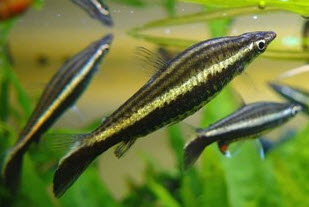
Lives: In the middle Amazon and the Rio Negro River. Description: The length of the elongated spindle-shaped body of the aquarium fish Pecilobricon vulgaris is five centimeters. Small terminal mouth. The color of the fish is not bright, but very pleasant. The back has a gray background and appears reticulated due to large speckled scales. A golden stripe stretches across the entire body, immediately below it there is a very wide black stripe, which extends to the abdomen. The abdomen is silvery in color. The caudal fin has a transparent upper lobe and a black lower lobe, often separated by a golden streak. The pelvic fins of females are transparent; males have opalescent stripes on them. These stripes can easily determine the sex of even young fish. On the anal fin
Habitat: Waters of Southeast Asia (Thailand). Description: The size of acanthophalmus aquarium fish is up to 10-12 cm. In a mature female, greenish eggs are clearly visible in the abdomen. The male looks slimmer. Acanthopthalmus has many varieties that differ in body shape and color. The fish prefers a bottom lifestyle, loves places in the shade and with poor bottom lighting, eats anything, not very large feed, which sinks to the bottom.
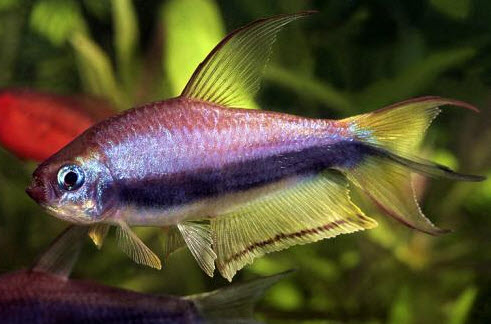
Habitat: Inhabits small forest streams in the northwestern part of the Cordillera (Colombia). Description: The body length of the royal tetra aquarium fish is up to 6 cm. The body is elongated, slightly flattened on the sides, the profile of the back is more curved than the belly. The back is olive-brown. On the side there are 2 wide shiny stripes, the upper one is light green to green-blue in color, the lower one is dark brown to black and goes to the middle rays “C”. The belly is yellowish-white. The iris of the eye is green-blue. The fins have a yellowish to light yellow-green border, under which there is a narrow dark purple stripe. The male has very elongated outer and middle rays. The female is colored less intensely, the middle rays are slightly elongated.
Lives: In water bodies of West Africa. Description: The body size of a male parrot fish is up to nine centimeters, a female is up to seven centimeters. Contents: Parrots are kept in aquariums that are densely planted and have shelters. Require clean water. They eat any food. Water with GH content up to 15; PH 6.5-7.0; t 22-24C.
Lives: On rocky areas of the coast. Description: The body length of Pseudotropheus zebra fish is up to 15 cm. There are a large number of color variations. Males are more lobed and larger than females. The anal and dorsal fins, like those of most other cichlids, are elongated in length. Males have yellow or orange spots on the anal fin, which resemble caviar in appearance.
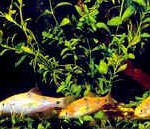
Habitat: Water bodies of Southeast Asia. Description: The body size of the aquarium fish clown barb reaches 10 cm. There are no pronounced gender differences, but usually females are larger in size. They are very unpretentious in maintenance. Water content: GH up to 10° or more; pH 6.8 or more; t 21-24 °C.
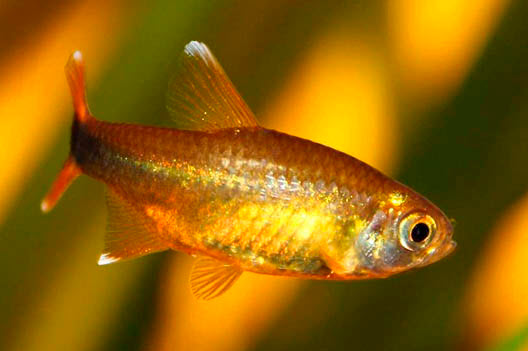
Habitat: Homeland - Sao Francisco River (Brazil). Description: Length 4-6 centimeters. The body background ranges from dark brick or brown (in males) to olive in females. A bright silver stripe stretches along the body. The unpaired fins of copper tetras have white streaks. Males are slimmer and smaller than females.
Lives: In Brazil (Southern Amazon, Rio Tocantis, Belem, Mato Grosso, Rio Madeira). Description: Very cute, delicately colored fish. Like other representatives of this species, the three-striped nanostomus does not have an adipose fin. It is one of the largest representatives of the species, despite the fact that the maximum length of its body is no more than 5.5-6 centimeters. Females are paler in color than males and plumper.
Lives: In the Brazilian rivers Iriria and Xingu. Description: Body length 10-15 cm. The body shape of bariancitrus aquarium fish is similar to ancistrus. The main background color is brown, with round spots of bright yellow scattered on it. The number and their size often varies greatly: from large quantity the smallest dots to rather large “freckles”. These are probably characteristics of different related species, but it is possible that different colors are characteristic of geographical forms of the same species.
Habitat: Mountain rivers of South America. Description: The male is up to 14 cm in size, the female is often smaller. The male has branched processes at the end of the stigma. Aquarium fish Ancitrus vulgaris is an armored catfish, it has horn-like suckers on its mouth, it scrapes off algae fouling in the aquarium with great activity. The greatest activity of catfish occurs at dusk, so it is advisable to have shelter in the aquarium in the form of cavities and crevices. The catfish’s body is covered with bone plates, so it is reliably protected. Ancistrus are very peaceful, and only males fight for territory, without causing any harm to each other.
Lives: In the Amazon basin, reservoirs of Guiana, rivers of Rio Negro, Parana. Description: Nannostamus beckford fish have a spindle-shaped elongated body, a small pointed head and a small mouth. Males are slimmer and brighter than females. They have a maximum length of less than six centimeters. Nannostomus have day and night colors: during the day the fish is bright, at night it becomes light, and blurry dark spots appear on its body.
Habitat: The aquarium fish Ctenopoma chocolate lives in the western part of the Zaire River basin (Congo). Description: Differences in unpaired fins and a characteristic pattern: they have a transparent back of the caudal, dorsal and anal fins. In this case, the caudal fin attracts special attention; in the front part it has a reddish color, and then is separated by a dark line with light edges from the transparent part. A large dark spot is located in the middle of their body; many individuals of the chocolate ctenopoma aquarium fish have a white coloration in the area of the chest and gills. The length of these fish can be up to 10 cm.
Habitat: In the Amazon delta, Para River. Description: Males of aquarium copella fish have an elongated caudal fin and reach a length of eight centimeters, females - six centimeters. The male has a white spot located at the base of the dorsal fin, which appears at an early age. In addition, females are slightly plumper than males. The general background color of the body of aquarium copella fish is beige with carrot-red streaks on the fins. Not very bright, but very interesting in its own way appearance and the characteristics of fish reproduction.
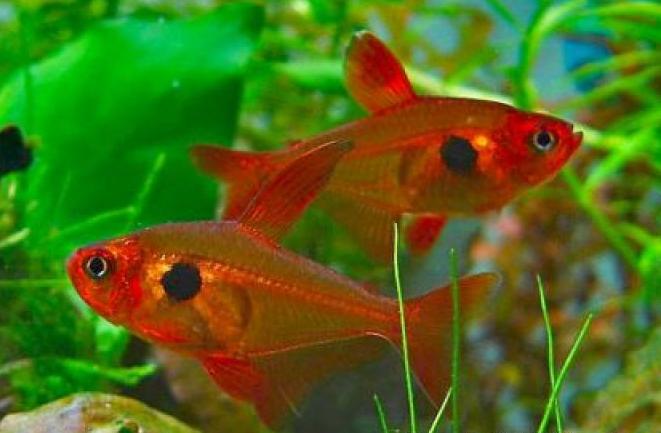
Lives: In the reservoirs of Western Guiana. Description: Minor fish have a laterally compressed, high, red body. Very often there is a dark spot on the side. The fish reach more than four centimeters in length. Females are plumper and larger than males. Callistus is often called “minor” in hobbyist aquariums. Veiled and albino forms have been bred in aquariums. Contents: Easy. the schooling, peaceful fish, however, does not mind nipping the fins of its slower neighbors. Water hardness 73 to 20°, slightly acidic, temperature 22-26 °C.
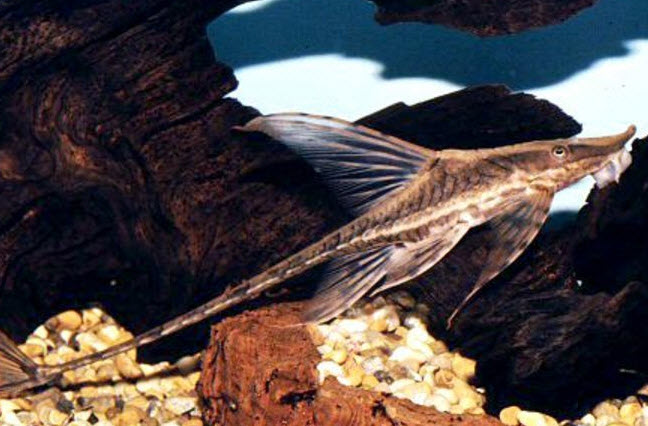
Habitat: Panama and northern and central parts of South America. Description: The body of the aquarium fish Sturizoma Panama is elongated in length, low, flattened from top to bottom, the head is elongated with a short outgrowth on the snout, the caudal peduncle is very long. Length up to 18 cm. The female is larger, the belly is strongly curved before spawning, it seems that the front part of the body is raised.
Range: Cameroon, Congo River basin. Description: The body length of the aquarium fish Synodontis veilata is 20-32 cm. A distinctive feature of the species is the elongated dorsal fin; with age, a braid appears on it. The coloring is quite bright for catfish: large black spots are scattered on a light background. There are small black spots on the head. The male is brighter, slimmer, smaller than the female.
Lives: In the Brazilian Amazon. Description: Neon green fish have a laterally flattened, elongated body. Between the caudal and adipose fin there is a clearly visible “flashlight”. Body length up to 4 centimeters. Females are larger and plumper than males. On the anal fin of males there is a hook, with which it clings to the fabric of the net.
The living inhabitants of the aquarium are both pets and an unusual element of the interior. To create an interesting living composition, fish are often selected by color. To do this, it is interesting to know what types of white aquarium fish are there?
White aquarium fish are found among many species. Typically this is albino forms. Such fish retain all the characteristics of the species, but there are no coloring pigments even in the eyes, so they look red, and the fish themselves may even be slightly transparent.
But, as you probably know, the albinism gene is always recessive, that is, the weakest, and it is easily lost. White albino aquarium fish are rare and often expensive.
To make white fish look their best in an aquarium, you need to choose ground and background dark uniform color, not variegated, so that the fish do not get lost. But the white color is fraught with a little difficulty in caring for the fish.
Many have external signs such as white plaque , spots or specks. It is quite difficult to notice such symptoms on white fish without looking closely at them. Therefore, if you decide to get white aquarium fish, be extremely attentive to them, observe the optimal value for the chosen species. temperature regime. Regularly inspect fish. The earlier a disease is detected, the easier it is to cure.
White goldfish
Among the hundreds of species of aquarium goldfish, there are white representatives of all breeds. Like a simple comet and shubunkin, as well as exotic water eyes and telescopes. White goldfish with red caps are very beautiful - oranda.
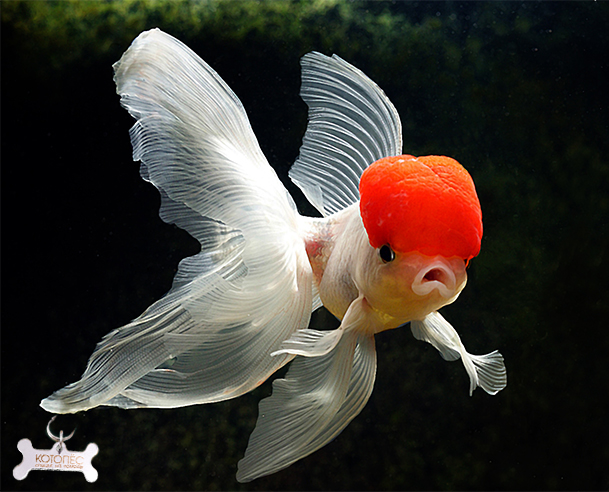
Oranda
Please note that goldfish prefer cool water about 20° C. Increasing temperatures and keeping goldfish together with tropical species often leads to various diseases, which are difficult to notice on white scales.
White livebearers and their neighbors
Poeciliids are perhaps the most popular fish. They are very unpretentious and perfectly compatible each other, which allows you to create interesting companies even in small aquariums. White varieties have corresponding names: “white prince” guppies, silver guppies, Bulgarian white swordtails. The latter sometimes have a red head, and will go well with the pearl scarlet guppies, which have a white body and bright red fins.
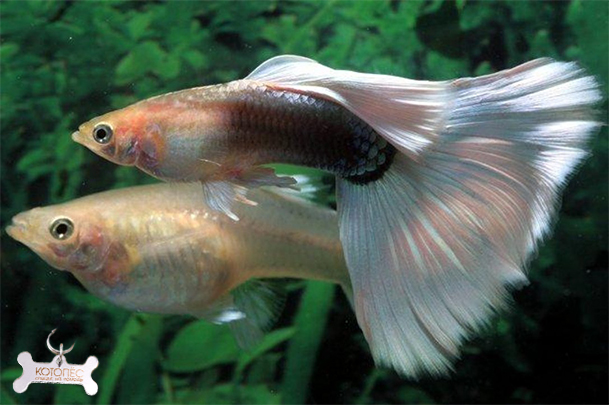
Guppy "White Prince"

Silver molly
- good neighbors for most types of aquarium fish. White catfish are found among corridors— albino speckled catfish. They come completely white or with a golden tint.
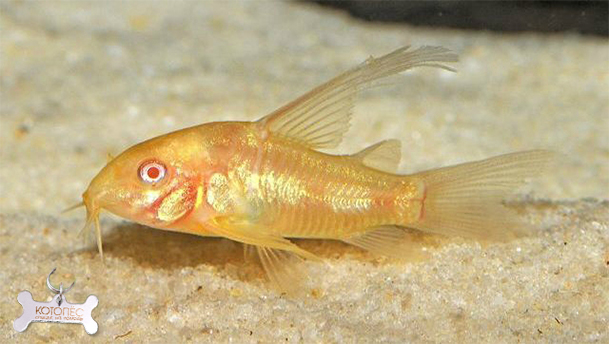
Veil Corridor
White aquarium fish are completely indifferent to the company of other peaceful fish. Even one cockerel is enough to admire its luxurious white fins, like sails, for a long time.
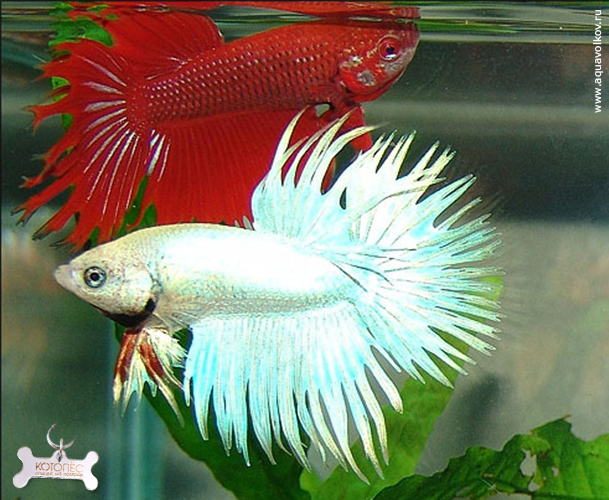
Crown-tailed cockerel
White cichlids
Amazingly beautiful aquarium fish - white angelfish. Looking at their graceful long fins, you instantly understand why the angelfish was nicknamed "". It is better to keep the angelfish in a species deep aquarium, half planted plants. Believe me, you won't need to move anyone else in. An aquarium with seven to ten angelfish will be surprisingly picturesque.

Fans of large forms can choose more serious ones - pseudotropheus or anstronotus in albino form.
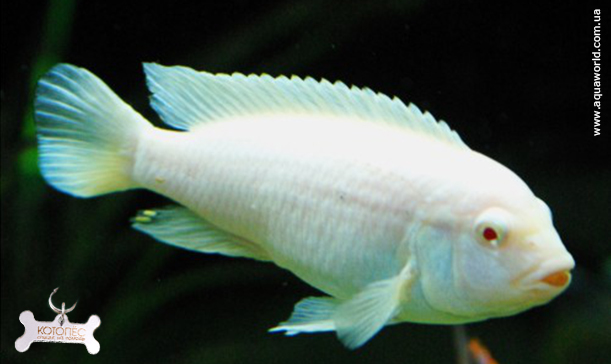
Pseudotropheus
Cichlids are predatory and aggressive fish. Their cannot be combined among themselves and with smaller fish. Best aquarium for them it is specific. But even a couple of large cichlids will give their owner many interesting moments in observing them. According to experienced aquarists, these fish have character.
There are about twenty-five thousand species in wildlife sea fish. Not everyone is able to survive in captivity. And keeping them in an aquarium is not always appropriate. In a home marine aquarium you can create a very bright, varied, fascinating - fairy world. Here are the most suitable fish for such an aquarium:
Clown fish. Undoubtedly, the favorites of all aquarists are clowns, of the Pomacentra family. They are reef inhabitants of tropical and subtropical seas. The appearance is dense, strong, and the color is bright and contrasting. Clowns are a favorite of fish due to their small size and high resistance to diseases and harmful factors. The behavior of clowns is also unusual. They coexist with poisonous polyps. Clown fish form a symbiosis with sea anemone. First, the clown allows itself to be stung, and then produces a certain protective substance in order to settle near the poisonous polyp, which, in turn, will protect it from predators. At the same time, the fish take care of their sea anemone, diligently remove leftover food, condition the water, and attract other fish to feed the polyp. This is how clown fish and sea anemone benefit each other. The clownfish feeds on algae and zooplankton.
You can fence your aquarium, or make a niche for it, for which you can use the so-called sandwich panels. You can select them from the list of sandwich panel manufacturers.
Amphiprion is also one of the amazing representatives of the same species. The orange amphiprion is a very bright fish with large orange and white stripes. One flock contains one adult breeding pair and several males. Amphiprion, in general, is a fairly peaceful fish, especially when there is one school per polyp in the aquarium. If there is space, it is recommended to have two sea anemones in the aquarium, for possible new family. Many pomacents feed on worms, crustaceans, echinoderms, and some on algae and plankton. These are very active fish and love to hide in numerous shelters.
Nemo is one of the varieties of clown fish. In nature, it lives in coral reefs. It is up to 9 cm long. The color of these fish is bright orange, with three white stripes. All young individuals are males. Next to one sea anemone there is one spawning pair and two or three asexual fry. Nemo fish acquires sex throughout its life, mainly when the female dies. This fish feeds on small invertebrates and algae.
The blenny, a member of the blenny family, is a bottom-dwelling hermit. They are ideal for a reef aquarium; in their natural environment they live on reefs and keep the algae they feed on under control. In aquariums they eat algae, other greens, and frozen food. A very popular genus among aquarists is the blenny fish. Small fish with an elongated body, they look like eels. Most often, blenny fish live alone in caves, in reef crevices, bury themselves in sand or inhabit mollusk shells. In the home aquarium, she has few enemies: only moray eels and stingrays, and also does not get along with needle fish.
Surgeon fish are the dream of all aquarists. In the aquarium, they are striking due to their unusually rich blue color with a yellow stripe, as well as bony outgrowths that resemble scalps.
The surgeon was drying up. Perhaps the most spectacular representative of this genus is the surgeon sokhal. Its body is steel-gray in color, streaked with black stripes. The orange tail spike and the spot behind the gill cover stand out very clearly against the black and white background. The length of the fish is 8 cm, and in nature it reaches up to 40 cm. Living in an aquarium, the fish requires 700 liters for one individual. Since the tireless swimmer was drying out, requiring a lot of free space. Fish can be aggressive towards fish of their own kind. Therefore, it is better to keep them alone. The surgeon may be very unfriendly towards other types of fish. IN community aquarium it is best to populate it last. But only sharks and moray eels can threaten him. The fish feeds on algae and sargassum.
ORDER Cypriniformes (CYPRINIFORMES)
SUBORDER CYPRINOIDEI
FAMILY Cyprinidae (Cyprinidae)
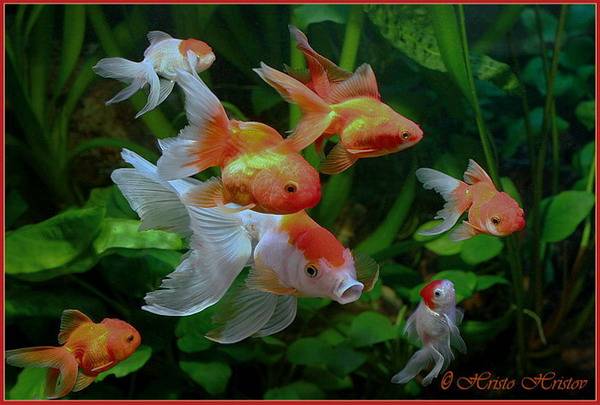
Genus Carassius - Carassius.
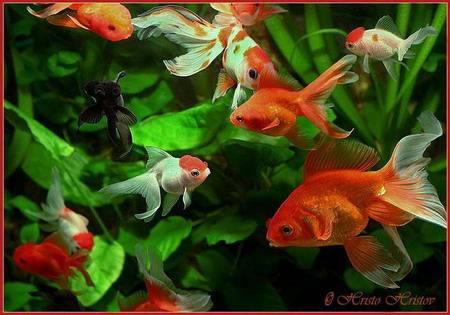
– Goldfish -- Carassius auratus auratus (Linne, 1758). Brought out in China as a result of selection. The wild form is common in China, Korea, Japan, the islands of Hainan and Taiwan; All goldfish are descendants of the silver crucian carp. 10–40 cm. 2 species are known, distributed from Europe to China. The ancestor of the goldfish is apparently the golden crucian carp Carassius a. gibelio (Bloch, 1822). This subspecies turned out to be very flexible, and certain features of the original form were enhanced depending on the conditions of detention. The black and golden specimens obtained in this way were used as the starting material for developing the very diverse, original forms that currently exist. Painstaking selection work, many of whose secrets were passed down from generation to generation, led to the emergence of several hundred new breeds. Nevertheless, even today, skillful maintenance and breeding of various, including new, breeds of this fish is not an easy task, requiring a lot of patience and knowledge. The typical color is orange-red-gold, with bright white, black, green and spotted varieties available. The female has a more rounded abdomen; in males, small white tubercles appear on the gill covers and outer edges of the pectoral fins during the spawning period.
Peaceful fish. All breeds of goldfish can be divided into two large groups: long-bodied and short-bodied. Long-bodied - similar in shape to their wild ancestor. The figures of short-bodied animals are distinguished by their elaborate variety, but they are always strongly compressed in the direction from head to tail. Short-bodied goldfish, compared to long-bodied ones, are quite delicate creatures, because deformation of the body shape natural for the species does not go unpunished, and the ability to adapt in short-bodied breeds turned out to be significantly reduced. There are many variations of goldfish bred by breeders. Forms with long fins and a very rounded body are slow swimmers. Long-bodied fish live up to 40 years, short-bodied fish live up to 15 years, and by 8–10 years they stop reproducing.
Contents: The aquarium for them needs to be spacious, low and wide, with a good oxygen regime, with a soil of pebbles, coarse sand or coarse gravel, since fish burrow in the sand and strongly disturb the water. To get rid of turbidity, powerful filters should be placed in the aquarium. A voluminous aquarium is required (with a lack of movement, all elite breeding forms become inert, and motor and metabolic complications arise). For short-bodied fish, 1.5 dcm is needed. area for every 10 cm of body length of all fish, for long-bodied fish 2 dcm. Short-bodied goldfish (veiltails, telescopes) require more water than long-bodied goldfish (common goldfish, comet, shubunkin), with the same body length. The oxygen content must be high. In an aquarium with veil tails, intensive water filtration or daily water changes are necessary. If the fish swim with their mouths raised to the surface, trying to capture air, this means that the water is not sufficiently saturated with oxygen. Then you should increase the blowing or replace some of the water with fresh water. Change the water regularly, weekly about 25% of the aquarium volume. The chemical composition of the water is not particularly important, but dH is better not lower than 8°. In an aquarium with goldfish, lighting is needed not only for the plants; without good lighting, the bright colors of the fish will fade. The water temperature is from 8 to 30°C, the optimum should be considered in the spring-summer period 18–25°C, in winter – 10–18°C. In summer, the temperature should be higher, but it needs to be increased gradually. The coldest water: Comet, Shubunkin. Hardness 8–25°, pH 6–8. At feeling unwell fish, you can add salt to the water - 5–7 g/l. The fish tolerate a salinity of 12–15% well. In some places there are plants, but not with small leaves, because... Dirt, lifted from the ground by fish when digging, settles on them. Therefore, in an aquarium with goldfish it is recommended to plant plants with hard leaves and a good root system, such as Vallisneria, egg capsule, sagittaria, or the most hardy ones, such as elodea. The beauty of goldfish is also fully revealed only against the backdrop of lush greenery. They often damage their lush fins on the hard leaves of plants that should not be planted. Plants are best planted in pots. It is better to keep all veiled forms separately from other types of fish, especially fast-swimming ones, such as barbs, which can bite their fins. In aquariums containing fish with bulging telescopic eyes, there should be no shells, stones with sharp corners and hard plants. In addition, these fish have poor vision and are very slow, so in public aquariums they do not have time to eat food and may die from exhaustion. It is also better to keep these breeds of goldfish separately.
Feeding: Goldfish are omnivores, but the food should be varied. The food is varied, preference is given to bloodworms, tubifex, earthworms, and large daphnia. On the surface of the aquarium, it is desirable to have an area with floating plants (riccia, duckweed), which feed the fish. They eat well scraped meat, fish fillets, and white bread in small quantities. These fish are voracious, and to avoid obesity they should not be overfed. Excess dry food can cause inflammation digestive tract. An abundance of food is especially dangerous at low water temperatures, when metabolic processes are slow. Goldfish require less protein than tropical aquarium fish and more carbohydrates. Therefore, numerous companies produce a special diet for goldfish in the form of flakes and granules. It must also be remembered that when feeding dry food of any kind, they should be given in small portions several times a day, since when it enters a humid environment, in the fish’s esophagus, it swells and increases significantly in size and can cause constipation and disruption of the normal functioning of the digestive tract. organs of the fish, which may result in the death of the fish. You can first keep dry food for a while (10 seconds flakes, 25 seconds granules) in water and only then give it to the fish. Although goldfish are voracious, you should not give them a lot of food. You should especially avoid overfeeding bloodworms. We must remember that it is better to underfeed the fish than to overfeed them.
Reproduction: When kept in good conditions in the second year of life, fish become sexually mature, but for breeding it is better to use fish that have reached 2–3 years of age. Goldfish are usually very difficult to determine the sex of. With great experience, you can notice that the anterior ray of the pectoral fins of the male has serrations. Females are slightly more plump. The manifestation of sexual differences intensifies during the mating season. In March-April, when daylight hours begin to noticeably lengthen, young males begin to swim after females, holding on to their ovipositor. By this sign, you can accurately identify mature fish that are ready for spawning. A male ready for spawning has characteristic differences: a saw on the first ray of the front pair of pectoral fins in the form of a series of notches, and warts appear on the gill covers, usually the size of grains of semolina. The female has a thick belly filled with eggs. 40-50-liter aquariums can serve as spawning grounds for short-bodied breeds, and 60-100-liter aquariums for long-bodied ones. Two to three weeks before spawning, the spawners should be kept separately, preferably at a low temperature. Spawning is stimulated by the addition of fresh water. Usually 2-3 males are placed for spawning for each female. A water level of 15–20 cm, strong aeration, and bright lighting in the spawning aquarium stimulate spawning. Temperature 20–26°C. Substrate – small-leaved plants, synthetic fibers, etc. Productivity: 2–10 thousand highly sticky eggs. After spawning, the producers begin to greedily eat the eggs, so either the fish are removed, or the substrate with the adherent eggs is transferred to a previously prepared aquarium. Incubation period lasts 3–4 days, after another 2–5 days the juveniles swim. A fry that has just hatched from eggs is very weak and helpless. It looks like a string with two eyes at one end and gallbladder in the middle. They should be fed “live dust”. The juveniles develop quickly, but unevenly. At one month of age, non-standard fry should be discarded. As the fry grow, they must be sorted by size to prevent cannibalism.
The young of the scaly varieties first have the silver-gray color of their ancestor - the crucian carp. This color turns to gold, white and pure black at 3-5 months of age. Some part remains unpainted until old age. The scaly ones always change their color, the last ones being white. Coloring, with rare exceptions, goes from darker to lighter colors: from black to red, from red to white. The picturesque variegated red and black colors are not permanent and turn red over time. Scaleless fry do not go through the period of silver coloring and already at the age of one and a half months they begin to turn into their final color. At 2.5 months you can already get an idea of the final coloration, although the best calico colors take 2-3 years to fully develop. Short-bodied ones live up to 15 years, long-bodied ones up to 30 years.
Thanks to its amazing plasticity and as a result of long-term selection work, Chinese fish farmers have developed many varieties of goldfish. The main forms of goldfish in China and Japan are called wakin, demekin, ryukin and ranchu. There are many varieties, the exact number of which cannot be counted. R. Pikhocki, in a book about goldfish, gives the following classification of differences in the characteristics of goldfish breeds common in China: 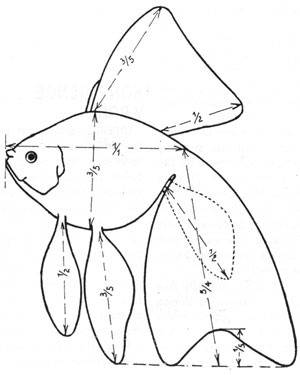
-- Color: grey, red, yellow, black, white, spotted, blue, purple and speckled.
--Body Shape: narrow and long, round and short (ovoid).
-- Dorsal fin: normal, rudimentary, absent, long, short.
-- Tail fin: simple, forked, simple above and forked below, hanging, enlarged triple, long, medium length, short.
-- Anal fin: simple, forked, simple above and forked below, rudimentary, absent, long, short.
-- Head Shape: normal, narrow, wide, “lion”, “goose”.
-- Eyes: normal, small, like a “dragon”, “heavenly eye”, “water eyes”.
-- Scales: normal opaque, transparent, pearlescent, absent.
The most common breeds of goldfish are.
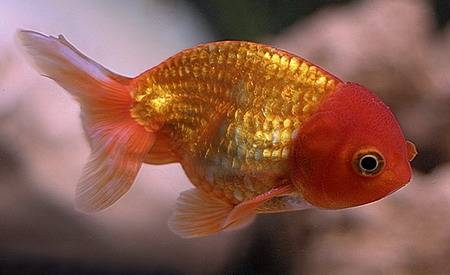
- Ranchu. Buffalohead, lionhead. The body is short, rounded (height to length ratio 2:3), ovoid, swollen, covered with scales. This variety is characterized by the fact that the foretail ends abruptly from the back. The posterior part of the dorsal profile forms an acute angle with the upper outer edge of the caudal fin. All fins are paired. Characteristic Features it is the presence in the upper part of the head and on the gill covers of massive translucent growths that arise from skin compaction and resemble a lion's mane or a raspberry, which begin to form in fish from 3 months of age. The growth is much larger (covers the entire head) than that of the oranda; sometimes it is so large that it covers the already small eyes of the fish. The growths are fully formed after two years, and are especially impressive at the age of 4-5 years. According to Japanese standards, the growths should be bright red. There are varieties in which the head does not have growths, the caudal fin is fused with blades, the body white with large red spots, the head and fin are bright red (Osaka Ranchu), and those with growths much wider and higher than the body (Okamo Ranchu). There is a variant without growths, called maruko in Japan, but their lips, eyes, gill covers, fins are covered with a scattering of small colored dots, and their body is white. The dorsal fin is absent, and the remaining fins are small and short. The caudal fin is three-lobed or forked in length, equal to the body, forked in shape with 4 processes, the edge of the upper lobe should not fall below the line of the back. In this variation, the caudal fin should be fused, the body should be white with large blurry red spots, the head, gills and all fins should also be red. The body is golden or light red, the growth is intense red. The body color is pale, with randomly scattered colored spots, often contrasting with the color of the growths on the head. Eyes, lips, gill covers and fins must be colored. In Japan, red specimens are considered the most popular. There are also red fish with white spots on the body; with a white body, shiny snout and fins or with a red gill cover. Lionheads can be red, red-white, calico, brown (chocolate), white-black. Red-black lionheads are very impressive and are in high demand, but when buying such a fish, you should keep in mind that the black parts of the body can change color over time, and the fish will turn orange. The process of “repainting” takes a long time and can drag on for a year or more, so you will have time to admire your fish. The breed includes Chinese or red lionhead. Its main differences lie in the massive translucent intense red growth on the top of the head and on its sides. Some authors, under the name “ranchu,” combine all breeds of goldfish without a dorsal fin. Lionheads are delicate fish. As the content of organic substances in the aquarium water increases, the growths on the head may become covered with fungus or begin to collapse. In addition, the fish may develop gill rot. It is impossible to increase the stocking density when keeping these fish! In pools, fish grow up to 8-9 cm in a year, and up to 18 cm in six years (such specimens are not found in an aquarium).
-- Nanjing is a goldfish from Izumo. An original and rare variation of ranchu. It is bred in the province of Izumo and is not exported outside this region. In Japan this breed is very protected. The fish has a small head without growths, normal eyes, a small forked tail, and an elongated, flat foretail. The shape resembles a duck egg. The color is red copper, with red fins and a slightly reddish head; there are also individuals with variegated spotted colors. Adult specimens are quite large. 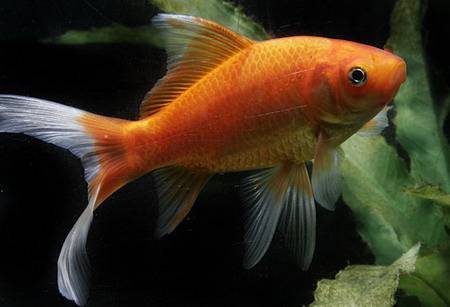
-- Wakin (Weikin), Tosa or Japanese goldfish, fantail, up to 30 cm. Similar in shape to regular goldfish. It is distinguished by an elongated body and a short forked tail. The whole beauty of this little fish lies in its tail - the edges of the blades of the fused tail have a wavy line. Some authors refer this name to goldfish-like species with a forked caudal fin. It is believed that this key mutation subsequently led to the development of split-fin breeds. The offspring are not always stable; there are individuals with a caudal fin with fused upper rays, with an unforked upper half, and even with a completely unforked tail. If the fantail is kept in an aquarium, then in some cases it develops elongated fins. Primary colors are red, white and red-white. The red color of these fish is predominant and can evenly cover the entire body and fins. It is often combined with white and black. Silver, pearl, gray, bronze, brown, gold and other shades are also possible - separately and in combinations; yellow, orange and other colors are often present. The edges of the tail - "fan" - are almost transparent. Rare in aquariums, most often found in large artificial reservoirs, decorative ponds in gardens and parks. The conditions for keeping and breeding the fish are exactly the same as for an ordinary goldfish. Together with goldfish, they are suitable for keeping in a garden pond. 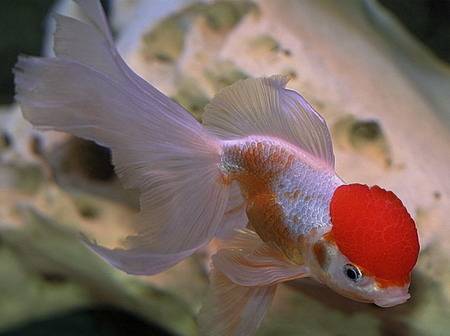
-- Ryukin. Veiltail (liukin, plume tail). Length up to 20 cm. One of the most common varieties of goldfish. It has a short, tall, rounded or ovoid (spherical) body with a short head and “expressive” eyes. The body height of the veiltail should be close to its length, being at least 0.6 of it. The eyes are slightly larger than usual. The head is quite large. The profile of the head smoothly transitions into the profile of the back. Home distinctive feature breed - a huge tail, consisting of two or more fins fused together, forming folds and hanging down like a veil. With a body length of 8-10 cm, the tail can reach 30 cm (or more in particularly rare specimens). There are descriptions of veiltails in which the size of the caudal fin is six times the length of the body. The length of the caudal fin should be at least 1.2 times the length of the fish’s body. If the cutout of the caudal fin does not exceed 1/3 of the length of the fin, the veil tail is called a skirt tail. The tail and fins are ideally almost transparent. The forked veil caudal fin has a particularly elongated shape, and sometimes consists of three or four fused fins, forming folds and hanging down like a veil. The longer the tail relative to the body itself, the more valuable the fish is. The dorsal fin stands vertically, spread out like a flag and should have a length in the front equal to the height of the body. The pectoral and anal fins reach at least half the length, and the ventral fins reach at least 0.6 of the body length. All lower fins are paired and hang down freely. In the offspring of veil-tails, there are often fish that are distinguished by an unforked, single caudal fin - a single-tailed veil-tail - they are called Nymphs. In this case, the anal fin is also single. The caudal fin is usually spread back. The single-tailed veiltail is distinguished by greater stability and liveliness of movement. Veiltails are divided into scaly and scaleless. A prized veiltail should be bright red with white to light cream, with a dorsal line that extends into a high arch, as well as a thickening of the tail stalk. The color of the fish can be very different - from solid gold to bright red and black. Dark-colored fish are less common and more valuable. Spotted veiltails are very beautiful, their fins and body are colored in different tones. The fish reaches its full beauty after 3-4 years.
The fish is popular all over the world: there are clubs for fans of this breed that organize special exhibitions. Modern standards for veil fish have changed little from those at the turn of the century. The height of the dorsal fin should be equal to the height of the body, the minimum ratio of tail length to body length is 5:4, the length of the ventral fins should be 3/5 of the length of the tail. The curve of the back should smoothly transition into the line of the tail, the caudal fin itself should look like a train, gracefully falling down. The dorsal fin, in addition to being of sufficient height, must have such rigidity that the fish can constantly keep it extended. Peaceful, calm fish, love to rummage in the ground, demanding a high oxygen content in the water. Unlike goldfish and comets, veiltails are more demanding in terms of keeping and breeding conditions. They need very spacious high aquariums with clean water (its salt composition of great importance does not have). Veiltails are slow in movement and unstable. There should be no fish in the vessel that could grab the veiltails by the fins. It is best to keep only decorative varieties of goldfish in one aquarium. Representatives of this species are more susceptible to various diseases, and their longevity is significantly less than that of representatives of long-bodied varieties of goldfish. Water temperature 20-22°C. 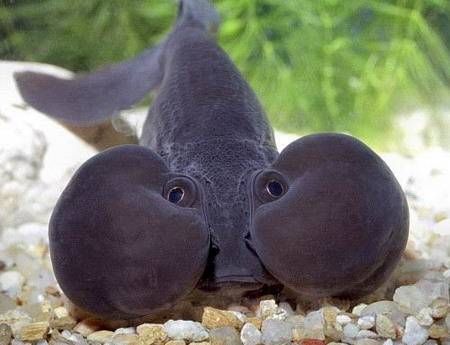
- Suignon. Water eyes. 15-20 cm. The body shape and plumage of the fish resembles the celestial eye (astrogazer). But the structure of the eye is anatomically different. It is characterized by fluid-filled blisters under each eye, hanging on either side of the head, with the eyes facing forward. In the best specimens, the “bubble” is equal in size to a quarter of the body. If the eyes are small, then the variation is called “frog head”. In fry, after 3-4 months, connective tissue begins to grow around the eyes, which forms peculiar bags. The eyes should be the same size and strictly symmetrical. There are three main eye shapes: round, cylindrical, cone-shaped. The first selection of eyes is done at the age of two months. Pay attention to the transparency of the iris. The body is ovoid or rounded, with a low back, the profile of the head smoothly blends into the profile of the back. The dorsal fin is absent, the remaining fins are paired, the caudal fin is two-lobed and does not hang down. The coloring is varied. Orange, silver and brown varieties of colors are common. The combination of a red head and a golden body is appreciated. Ordinary red fish are very good; the scales on their rounded backs have a beautiful bright shine. The eyes of these fish are especially vulnerable. They are filled with liquid and very tender, they can pierce and fall off, but with good maintenance they recover within 3-4 weeks. Therefore, special precautions are required when handling them, and even more so than when maintaining telescopes, especially when catching. Despite the fact that damaged bubbles are quickly restored, there should be no objects or algae with sharp edges in the aquarium. This species, like other long-finned goldfish, must be kept either alone or with other large but peaceful species. Fish often lag behind other breeds in growth. When breeding this breed, there are difficulties in selecting sires: you need fish with symmetrical eyes of the same shape and size and a flat (no bumps) back. 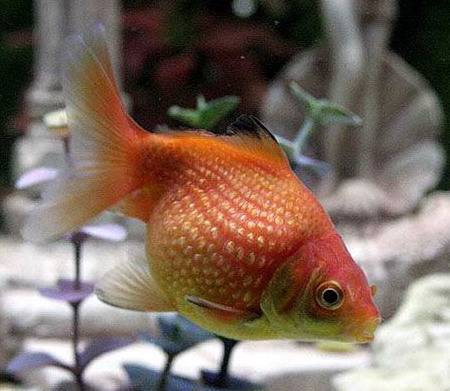
--Chinshurin. Pearl. Length up to 15 cm. Small (7-8 cm) egg-shaped body, short pectoral and ventral fins, dorsal fin and tail of medium length, anal fin forked. The body is short, dense, almost round, the back is low, the profile of the head smoothly merges into the profile of the back, the scales are raised dome-shaped. The dorsal fin is unpaired, stands vertically, equal to 1/2 the height of the body, the ventral fins are of the same height. Double anal fin. The caudal fin is two-lobed, four-pointed, cut out 1/3 of the length, does not hang down, the first rays are equal to 1/2 the height of the body. The remaining fins are short, often paired. The fry of these fish, already at 1-2 months of age, take on a rounded shape, characteristic of adult fish, and are very funny. The body color is predominantly orange, red, brown, white, gold, orange-red, as well as red and white spots, sometimes yellow or dark blurry spots - with large, bulging scales that look like pearls in reflected light. There are also completely white options. The main distinguishing feature is the large convex scales covering the entire body. Each scale is edged with a dark color; it is so convex and round (domed-shaped) that in the reflection of light it looks like small pearls, reminiscent of mollusk valves. When a pearlescent scale is lost, for example as a result of injury, a simple scale grows in its place. The pearl is a very delicate fish - certainly not for beginners. Susceptible to intestinal diseases and gill rot. It is demanding on the quality of aquarium water: there should be no nitrites and ammonia. The main thing when keeping it is proper feeding - the round shape of the fish often causes it to be underfed or vice versa. 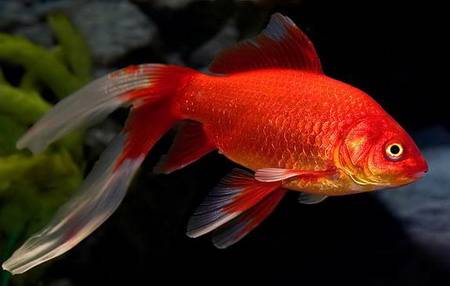
-- Sarasa comet. Comet. 18 cm. This is the simplest and most unpretentious variety of goldfish with a long ribbon-like (often forked) tail, and the caudal fin should exceed more than 3/4 of the body length, two-lobed with a deep cut, both tips should be the same length. The longer the caudal fin, the higher the specimen is rated. The anal fin should not be forked. The body is elliptical, elongated. Comets with a swollen body, like a veiltail, are considered defective. The developed dorsal fin and slightly elongated remaining fins give the fish a more harmonious appearance. Individuals with a short, rounded body and a forked anal fin (the latter is quite common) must be discarded. The color may vary, but those individuals whose body color differs from the color of the fins are of particular value (in China, those with a silver body have bright red or lemon-yellow fins that are 3-4 times longer than the body length). The color of the comet with red and white spots is especially attractive. The color of the comet can vary, but those individuals whose body color differs from the color of the fins are of particular value. In China, silver fish with a bright red or lemon-yellow tail, 3-4 times the length of the body, were considered especially beautiful. Despite the fact that comets grow and mature well in almost any conditions, they are difficult to work with. These strong, restless fish often jump out of aquariums. Females produce relatively few eggs. Together with goldfish, they are suitable for keeping in a garden pond. 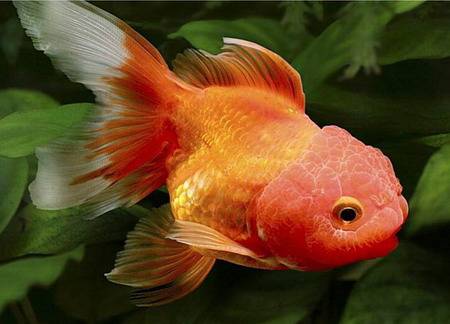
--Oranda. Oranda (shishigashira, lionhead, pompom). This is a type of veiltail, distinguished by growths on the gill covers and head. A special type of oranda is the Lionhead. 18-25 cm. A variation of the veiltail, considered a separate variety. The shape of the body and fins is similar to the veiltail, it is distinguished by growths of a granular structure on the head between the eyes and the upper part, gill covers reminiscent of a lion's mane, which gives the fish great originality. In the oranda, compared to the lionhead, they are more developed on the forehead. The body is short, egg-shaped, all fins are elongated. There is a dorsal fin. The anal and caudal fins are forked. A disadvantage is an unforked caudal or anal fin, as well as a weakly deployed dorsal fin. Orandas are the most variegated, most colorful elite forms of goldfish. The body, like the fins, is covered with variegated spots. This variety has many color variations - from white to red, variegated, orange, black, calico, etc. The colors of the fish are varied, but only those specimens whose “mane” color contrasts with the body color are valued. The most prized species is the white oranda with bright red growths on its head (red-capped oranda). Even from very good producers it is not possible to obtain more than 10-15% of such fish. A variety of oranda in which the growths appear as fluffy clumps on either side of the mouth (or occasionally on the nose) is called Giroshima, or bouquet nose. Unlike the oranda, these fish do not have a fatty growth on their head and they do not have a dorsal fin. The color is silver with a metallic sheen, the upper half of the head is orange or red. If the growth is at eye level, then this variation is called a goose head. A variation in which growths are located on both sides of the head above the mouth in front of the eyes or sometimes one growth on the nose with a diameter of up to 1 cm in blue, red, brown or white is called Giroshima (hanafusa or ganafusa, velvet ball, wool ball, pompom, nose- bouquet - names given by fish farmers different countries). Many tend to consider the Goosehead and Giroshima not as variations of the Oranda, but as independent breeds. Under poor conditions, growths may not develop, or may not develop completely and even disappear. Pom-poms are quite demanding in terms of living conditions. It should be noted that with insufficient care, the growths disappear and the fish loses its decorative look. The color of a pompom can be very diverse, but fish whose body color differs from the color of the growths are more valued. 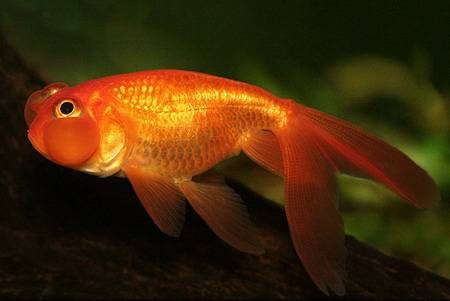
-- Chotengan. Stargazer, supergazer or celestial eye (chotengan). 15 cm. There are two variations: with a short body, like a telescope, and with an elongated body, the head and snout are short. The body is round, ovoid, the back is low, the profile of the head smoothly blends into the profile of the back. But in both variations there should be no dorsal fin (even the slightest scar devalues the fish), the remaining fins are short, the caudal and anal fins are forked, the edge of the upper blade should not fall below the line of the back. The elongated body shape and veiled tail are a deviation from the canon, but some see this as a new variation. It is characterized by bulging eyes, like those of a telescope, but they are directed upwards rather than sideways. Very reminiscent of a telescope in size and shape of the eyes, the eyes protrude above the head and the pupils are directed upward at an angle of 90 degrees and slightly forward. Fish with a shiny golden iris are especially beautiful. It is extremely difficult to obtain an impeccable stargazer when breeding: at best, out of hundreds of fish, you can select a few individuals. In terms of variety of colors, they are very inferior to telescopes and are almost always golden-brown - from pale to more saturated (dark). The velvet black form is especially rare and precious. All the beauty of stargazers is manifested in low and flat bodies of water, allowing you to view them from above. Like telescopes, they are best kept in wide, low aquariums that have been removed from anything that could in any way harm the eyes. For the same reason, it is better to keep them alone. The eyes of these fish should be protected from injury. 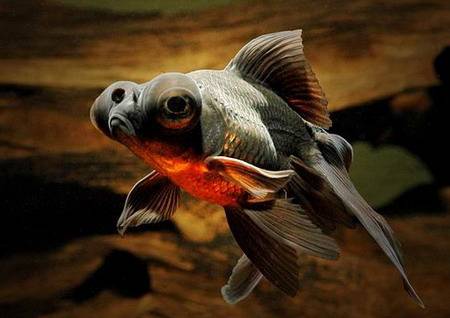
- Demekin. Telescope (water dragon). 20 cm. The body has the shape of an elongated chicken egg. The caudal fin is elongated, forked, the eyes are bulging. A telescope was taken out from Demekin. The telescope has the same body and fin shape as the fantail, but is distinguished by bulging eyes measuring 1-2 cm (in the best specimens bred in Shanghai, up to 5 cm). It has a swollen body of an ovoid or round shape, the height of the body is more than 1/2 of the length. All fins are elongated and the larger the better. The dorsal fin stands vertically, the remaining fins are long, veiled, the caudal fin is forked, often hanging down, longer than 3/4 of the body length. Particular attention is paid to the length and shape of the caudal fin - it can have the form of a ribbon (ribbon telescope) or a skirt (skirt telescope), which is more valuable, and should fall steeply down. Telescopes differ in the shape and length of the fins, the presence or absence of scales, color and some other characteristics. The longer the tail and the more prominent the eyes, the more beautiful the fish is considered. The scaleless veil-tailed telescope was obtained by crossing a Chinese scaleless telescope with short tail and veiltail. This type can simply be called a telescope, since it is a modern combination of the most interesting features of the goldfish: elegant and graceful fins, bright multi-colored colors and the striking grotesqueness of dragon-shaped bulging eyes. It is difficult to achieve a combination of these characteristics in the best manifestation of each. Therefore, the length and shape of the fins of the telescope are somewhat inferior to the fins of the veiltail, the color is that of the Shubunkin, the size of the eyes is the size of the eyes of the Chinese short-tailed telescope. Continued work on this type should improve it in all of these ways.
The uniqueness of the fish is given by telescopic convex (the more convex, the better) huge eyes with a diameter of about 1.5 cm (in the best specimens bred in Shanghai, up to 5 cm). Based on the shape, size and direction of the eye axes, several types of telescopes are distinguished. The main types of eye shape: dish-shaped, spherical, cylindrical, spherical, cone-shaped. The right and left eyes should be symmetrical, have the same size and a transparent iris. More often, spherical or conical eyes are found, less often cylindrical. Usually the eyes are directed in different directions and often somewhat forward so that the axis of each eye is perpendicular to the surface of the head. Telescopic eyes develop relatively late (between about 3-6 months) and are fully formed after the second year of life. With age, bulging eyes increase. A fry that is too “big-eyed” should alert you: it is very likely that it was poorly fed, and the fish are simply “dragged.” In general, however, the prominence of the eyes primarily depends on the quality of the sires, that is, it is determined by heredity. The longer the tail and the more prominent the eyes, the more beautiful the fish is considered. Male telescopes are quite active during spawning. This prompted their widespread use for “commercial” crossings, since in the first generation the offspring do not have telescopic eyes. But such eyes appeared in other breeds: Shubunkin, Ranchu, Pompom. It is almost impossible to get rid of the gene that causes such a trait.
Telescopes are divided into scaly and scaleless. Scaleless ones, in turn, are divided into single-color and calico (multi-color). Scaleless (single-color and variegated calico) and scaly (velvet black). The color can be varied: bright red (sharlah-demekin), orange with a metallic sheen (aka-demekin), calico (calico-demekin), black (kuro-demekin). Scaleless, in turn, on single-color and calico (multi-color). Single-colored ones are often red or white. The surface of the body of scaleless telescopes does not have the same metallic sheen as that of scaly ones; the fins are often white, sometimes mottled with black, less often with a red admixture. The red color of the scaleless is very beautiful scarlet shade. A calico telescope may have red, yellow, brown, gray, black, blue and lilac spots, usually located randomly on a lighter background. The best specimens have red spots on their fins, in addition to black ones. Specimens with a blue color are rare; the brighter it is and the larger areas of the body it occupies, the more valued the fish is. Telescopes with black and white coloring, symmetrically located throughout the body, are usually called pandas, and if the body color is white and the fins are black, they are called magpies.
- The telescope is black. Mostly black telescopes are common. The black telescope is considered the most perfect form among all veiled telescopes. They have large round eyes, the caudal fin is forked, shorter in length than the body, all fins are elongated. The height of the body is 3/4 of its length. This type of telescope is always scaly. The scales are arranged in even rows. The body is ovoid, rounded, the back is low, the height of the body is more than 1/2 of the length, the profile of the head smoothly merges into the profile of the back. Eyes on symmetrically located cylindrical or conical projections protrude on both sides of the head. The black telescope has an intense velvety black color, somewhat weakened on the belly to blue-gray or faint gold. In a particularly successful selection, the color should be uniformly black and brown. The entire body and fins are black. It should be noted that this color is not stable and may fade. Some experts believe that this depends on the quality of feeding, lighting intensity and the color of the soil in the aquarium - the darker the soil, the darker the color of the fish. An interesting variety of black telescopes with ruby red eyes. Telescopes, like other short-bodied breeds, are pampered and heat-loving. This especially applies to black-velvet ones, which are very popular. Black and calico telescopes are more thermophilic and delicate than other varieties, and are susceptible to disease at low water temperatures. 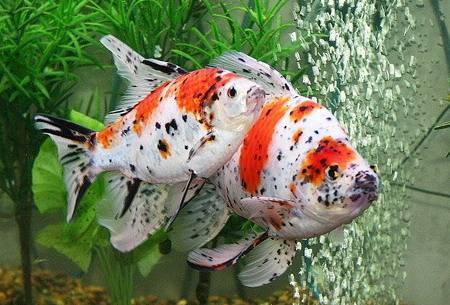
--Shubunkin. Shubunkin (Calico). 16 cm. An ordinary goldfish with slightly elongated fins. It is distinguished by transparent scales and extreme variegation. The scales are transparent, which is why the Shubunkin is often called scaleless. Distinctive feature- an elongated, laterally flattened body, similar to an ordinary goldfish. The fins are elongated compared to the goldfish. The dorsal fin is enlarged; The caudal fin is simple, deeply slotted, elongated and rounded. The breed also includes a species with a forked caudal fin, a slightly shortened body and a high dorsal fin. The longer the pectoral and ventral fins and the higher the dorsal fin, the greater the value of the fish. The form with wide, rounded fins is known as the Bristol Shubunkin. The most commonly sold fish are the London Shubunkin, which has a body shape similar to a regular goldfish, and the Bristol Shubunkin, which has a larger caudal fin. The most valuable thing about the Shubunkin is its coloring, which consists of a combination of white, black, yellow, red and blue flowers. An amazing mixture of colors and variations of patterns. The color is variegated, the most valuable is “calico” (black, red, blue, yellow and white spots on a blue background). Coloring appears in fish only after reaching a year. Blue tones usually appear at 2-3 years of age. Dark spots are scattered throughout the body and fins. Of particular interest is the Shubunkin, which is blue in color with dark red, brown, yellow and black spots scattered throughout it. Individuals with a predominant blue or blue-violet color are especially valued. Japanese breeders liked the calico variegation, and they also “colored” the telescope, oranda, veiltail, etc. And now you can find such names as calico oranda, calico telescope. Suitable for keeping in a backyard pond.


























